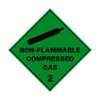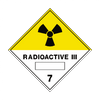No Products in the Basket
|
Class 1 Explosives |
||
|
Symbol |
Description |
Class 1 Explosive Examples |
|
|
An explosive is any chemical or item which is created to explode. An example would be a chemical reaction that would cause a dangerous explosive release of gas or heat. |
Pyrotechnics Fireworks Dynamite Gun Powder |
|
Class 2 Gases |
||
|
Symbol |
Description |
Class 2 Gases Examples |
|
|
A hazardous chemical gas which can catch fire and burn. Sub Class 2.1 Flammable Gas |
Methane Propane Butane Hydrogen |
 |
A compressed gas which is stored in a pressured container. Due to the high pressure of some containers, these gases can be very harmful if the container is damaged or if they are subject to a fire. Sub Class 2.2 Non-Flammable Or Non-Poisonous Compressed Gas |
Oxygen Aerosols Carbon dioxide Nitrogen |
 |
Toxic gases can be very lethal and poisonous to humans if there is a gas leak. In the event of a leak, the gases can spread quickly which can reduce the strength of poison but can still be very dangerous. Sub Class 2.3 Poisonous Gas |
Carbon monoxide Chlorine Methyl Bromide Ammonia |
|
Class 3 Flammable Liquids / Irritants |
||
|
Symbol |
Description |
Class 3 Flammable Liquid / Irritants Examples |
 |
Combustible liquids which can be very dangerous if ignited. They can also be irritants if they come in contact with skin. |
Petrol Kerosene Alcohol Diesel |
|
Class 4 Flammable Solids |
||
|
Symbol |
Description |
Class 4 Flammable Solids Examples |
 |
Combustible materials that can become reactive if they are exposed to friction. Some materials can become thermally unstable and dangerous, even with low volumes of Oxygen present. Sub Class: 4.1 Flammable Solids |
Coal Sulfur Sodium Sulfide Matches |
 |
These are chemicals or items which can instantly combust and can become self-reactive materials if exposed to air, this can occur without any kind of heat being applied. Sub Class: 4.2 Spontaneously Combustible |
Phosphorus Barium Potassium sulfide Sodium Sulfide |
 |
These are chemicals or substances which become flammable or emit toxic gases when they come in contact with water. Sub Class: 4.3 Dangerous When Wet |
Calcium Sodium Magnesium Lithium |
|
Class 5 Oxidising Chemicals |
||
|
Symbol |
Description |
Class 5 Oxidising Examples |
 |
Oxidising agents can greatly increase the combustion of other chemicals or materials. When the oxidising material or chemical is combined with oxygen, it can enhance the combustion of different materials. This means the material has been oxidised. Sub Class: 5.1 Oxidising Agent |
Chlorine Pool Chemicals Peroxides Nitrates Sodium Super Oxides |
 |
Organic peroxides are a type of oxidising chemical. They have a special sub class because these particular chemicals also have explosive properties under certain circumstances. If some organic peroxides are left out to dry, they become more dangerous over a certain time period. Sub Class: 5.2 Organic Peroxide |
Some Fertilizers Peroxides Ethyl Hydro Peroxide Acetyl Acetone Peroxide |
|
Class 6 Poisonous Chemicals and Gases |
||
|
Symbol |
Description |
Class 6 Poisonous Chemicals and Gases Examples |
 |
Poisonous chemicals pose serious health hazards if exposed to humans. If these chemicals are mishandled or swallowed, they have the potential to cause serious harm or even fatalities. Sub Class: 6.1 Poisonous / Toxic Chemicals Or Substances |
Mercury Nicotine Chloroform Arsenic |
 |
Sub Class: 6.1 Same health hazards as above but these are poisonous and toxic gases. |
Tear Gas |
|
Class 7 Radioactive Chemicals and Substances |
||
|
Symbol |
Description |
Class 7 Radioactive Chemicals and Substances Examples |
 |
Class 7 radioactive materials are extremely dangerous and contain radionuclides which emit ionising radiation. Ionising radiation can potentially cause serious risks to human health. Class Description: Radioactive 7 i |
Uranium Medical Isotopes Thorium Plutonium |
 |
Material in which radioactive material is distributed throughout & the average specific activity is: – ≤ 10 -4 A 2/gram for solids – ≤ 10 -5 A 2/gram for liquids. Class Description: Radioactive 7 ii |
Water with tritium concentration |
 |
Radioactive solids which are either consolidated wastes or activated materials meeting the requirements for §173.468. Radioactive radiation which is distributed throughout a solid, collection of solid objects, or solid compact binding agent (concrete, ceramic, etc). Radioactive Material is relatively insoluble or intrinsically contained in a relatively insoluble material so leaching in water will not exceed 0.1 A 2 after 7 days. Must have an average specific activity of ≤ 2 x 10 -3 A 2/g. Class Description: Radioactive 7 iii |
Radioactive solids |
|
Class 8 Corrosive Chemicals |
||
|
Symbol |
Description |
Class 8 Corrosive Chemicals Examples |
 |
Corrosives are types of chemicals or substances that can corrode, disintegrate or even melt different materials when they come in contact. Some corrosive chemicals have the strength to corrode some types of metal such as steel or aluminium. Class 8 corrosive chemicals can cause severe damage to humans if mishandled. |
Nitric Acid Mercury Batteries Hydrochloric Acid |
|
Class 9 Miscellaneous Goods |
||
|
Symbol |
Description |
Class 9 Miscellaneous Goods Examples |
 |
Class 9 Miscellaneous goods are chemicals or substances which are not covered by the above classes. Some miscellaneous chemicals can pose serious health and safety risks when they are transported. |
Asbestos Dry Ice Polymeric Beads First aid Kits |
Hazchem Labels |
Hazchem Signs |
|
|
|